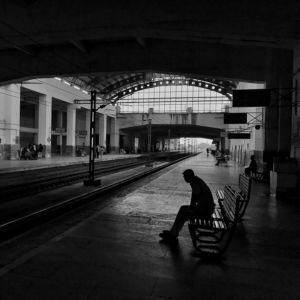
Last week's newsletter message about David Breaux hit a chord in so many people. He was a gentle man who spent endless hours on a bench, listening to people. He gave them a prompt, asking what they thought compassion meant. He was not inviting a philosophical conversation but a heartfelt conversation.
So much sharing can happen on a bench. Often, it provides a place in which a conversation without a specific intent starts, which then opens up a pathway to understanding between those who share space on the bench. Ironically, a number of our compassionate communities are involved in strategically placing benches and inviting people into healing conversations.
Last week one of our partners, the Global Compassion Coalition, published an article by Olha Samborska, a teacher of Ukrainian students in Berlin. Her work is to address trauma in their lives. Earlier this year, she wrote of an incident observing a woman sitting on a bench at the train station. She was on one bench, the woman on another. One could only speculate on what would have happened if they shared the same bench. Below is Olha's story.
With warm regards,
Marilyn
I was sitting in the subway station waiting for my train. Behind me, an old woman sat on a metal bench and muttered something. At first, I did not listen until her voice became louder and louder and pierced my consciousness. Between the mutterings, I heard the words Sachsenhausen, Potsdam, Holland, and bombing. When I heard the last word, I began to listen closer because bombing is clearly associated nowadays with Ukraine. But what does the bombing have to do with the old woman on the bench?
Then I began to catch the meaning of her delirium because she was talking exclusively to herself. There are many such people in Berlin. Homeless people or just sick people who were made ill by trauma. The story of an old woman in an orange beanie and a COVID mask was not really very clear, but I understood the following: she survived the horrors of the bombing of Nazi Germany as a child. Her mother, to escape the war, fled to the Netherlands, where they were rescued by a Dutch woman. It seems that they lost their house in Potsdam, and someone from their family, possibly their father, was sent to Sachsenhausen concentration camp.
The woman was spinning this story back and forth, repeating words and even whole sentences. I was frozen in confusion. The arriving train had woken me up. And although I had to get up and go to my train, I could not move. I quickly recorded her last remarks on a dictaphone and instantly jumped onto my train, leaving on the platform a human part of the post-history of the Second World War, which resonates in the generation of children who survived it. It is clear that the trauma of war does not end when the war ends but lives on in its victims for a long time, and maybe even till their deaths.
Even when the old traumas of the last century's war have not yet died, there are more recent, other wars already raging and producing new traumas. What will our Ukrainian children be like in 40–60 years, when traumas will become especially active? Studies have shown that childhood traumas are activated by changes in the body's hormonal state, especially during midlife crises. It is difficult to predict the consequences.
We only know that we need to work with traumas now. It is necessary to talk about traumas with relatives, friends, and psychologists. Trauma is not just the experience of shock and distress. Trauma is what remains in the memory if it is not processed in a human way. Parents should understand that the stress of war is passed on to their children, even if they do not talk about it. Children cannot run away and cannot take up arms. The only thing left for them is depersonalization as a defense mechanism of the psyche against madness.
To prevent this from happening, children need a constant sense of security from parents or loved ones. Unspoken trauma will speak decades later, just like the old German woman on the platform of the Berlin subway. She can hardly be helped, but she helps herself by talking about what happened to her 60 years ago. The trauma has no countdown because it lives its own life, settled at the bottom of the subconscious. Unfortunately, people are arranged in such a way that they are guided by their memory board all their lives, and they even pass trauma from generation to generation if it is not cleaned of debris, not brought to the surface, to the light.
Everything dark is afraid of the light. Therefore, I bring this story here, in the virtual space, to remind you that traumas, as parasites, are planted in a person when they or their soul is in the most vulnerable state. Traumas inhabit the empty space in a person that is available when the soul, due to unprocessed trauma, is still actively searching for an escape.
But psychological trauma can be expelled if the person is filled again, if the soul is returned to its place, freed from the fear that in turn may cause, in that person's life, fear of love and care of others. I can't imagine this is not what happened to the traumatized woman on the platform. But what happened, happened. Everyone has their own way. Someday she will be free from the trauma parasite, if not in this life, then in the future journeys of her soul. I only wish the world would get rid of wars that produce traumas.


